Canon DSLR cameras have a well-deserved reputation for excellence. Whether you’re into sports, wildlife, travel, or simply taking great pictures, there’s a Canon DSLR for you. The first Canon DSLR hit the market in 2000, and the last one, in all likelihood, was released in 2020. That’s two decades of continuous innovation, iteration, and improvement, resulting in remarkable cameras.
However, the era of photography has evolved. DSLRs no longer rule the photography world, with mirrorless cameras taking the spotlight. Canon is focusing on its EOS R mirrorless line, introducing entry-level models like the Canon EOS R50 and Canon EOS R100. This shift aims to cater to photographers of all skill levels, aligning with the growing preference for mirrorless cameras. But DSLRs have their unique appeal, from the optical viewfinder’s immediacy to the satisfying mirror mechanism sound.
Canon DSLRs still hold an edge in terms of lens variety, especially affordable options. Two decades of history have resulted in a range of lenses for DSLR users, catering to photographers at all skill levels. Canon DSLRs remain fantastic tools for capturing stunning images.
The Best Canon DSLR Cameras in 2024
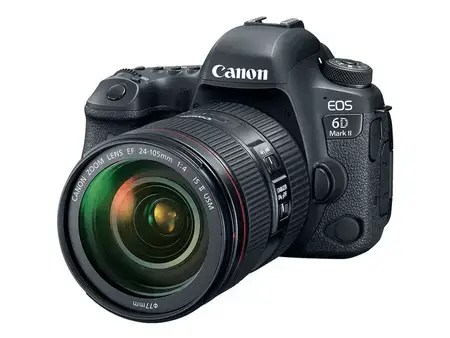
Canon EOS 6D Mark II
Best budget full-frame Canon DSLR
The camera excels in handling and ergonomics, with a user-friendly control layout. It offers a fully articulating 3-inch touchscreen and a weather-sealed body.
When shooting in Live View, the EOS 6D Mark II delivers robust autofocus performance, thanks to Canon’s Dual Pixel AF, covering over 80% of the image area. This feature enables quick and precise focusing for both photos and videos, even in challenging lighting conditions.
Pros:
- Full frame, 26.1MP.
- Vari-angle touch monitor.
- Fast shooting.
- In-camera Raw processing.
Cons:
- Single SD card slot.
- The viewfinder AF array is relatively small.

Rebel T100 / Canon EOS 4000D
Best cheap Canon DSLR
While the EOS 4000D is Canon’s most economical DSLR, it still provides essential features, making it suitable for budget-conscious photography students or complete beginners interested in exploring photography. It offers reliable focusing and exposure systems for those who want to venture beyond full auto mode. Surprisingly, it features a 63-zone dual-layer exposure meter, delivering excellent results across different lighting conditions. Despite a basic nine-point autofocus system, it performs efficiently and responsively.
This camera’s 18MP APS-C sensor, though dated, is sufficient for most purposes, and it offers a native ISO range of 100 to 6400. It also includes a pop-up flash for low-light photography.
Pros:
- Compact and lightweight.
- Excellent value at this price point.
- Integrated flash.
Cons:
- Limited to 18 megapixels.
- Just nine autofocus points.
- Supports Full HD video only.
- Small rear monitor.
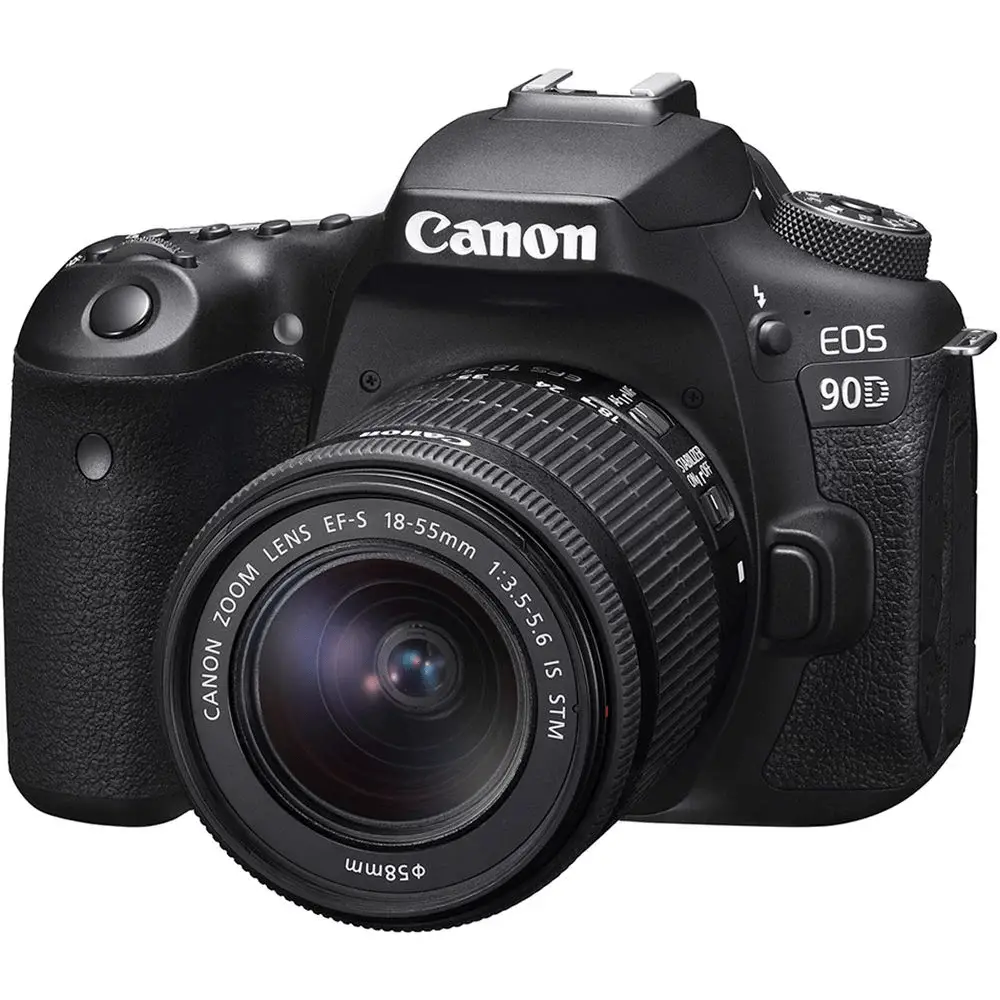
Canon EOS 90D
Best Canon DSLR for sports and wildlife
With its high resolution, the EOS 90D caters to photographers aiming for large, detailed prints with excellent dynamic range and true-to-life colors. While shooting in raw format delivers fine detail, JPEGs straight out of the camera are also impressive for a more efficient workflow.
This camera’s high resolution opens up opportunities for fine-art and macro photography, allowing cropping for intricate details without compromising image quality. The 1.6x crop factor enhances its suitability for wildlife photography.
Beyond stills, the EOS 90D is an excellent choice for vloggers. It features a monitor that can swivel to face forward, and shooting 4K video comes without a crop. Additionally, it offers headphone and microphone sockets. In essence, the EOS 90D is a well-rounded camera for enthusiasts, even boasting high-speed continuous shooting capabilities.
Notably, the Canon EOS R7 in Canon’s mirrorless range is its closest rival, but it has a more limited lens selection unless you don’t mind using Canon EF-S DSLR lenses with an adapter.
Pros:
- 10fps shooting.
- High pixel count.
- Solid build.
- Dual Pixel AF in Live View.
Cons:
- Autofocus through the viewfinder is not as efficient as in Live View.
- No USB charging.
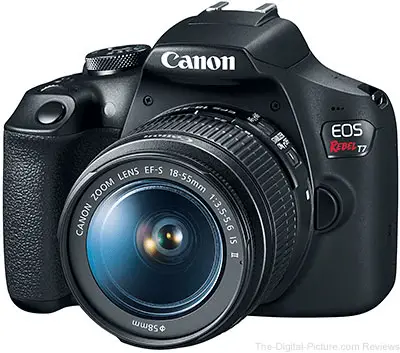
Rebel T7 / Canon EOS 2000D
Best Canon DSLR for beginners
The EOS 2000D is an ideal camera for users who aim to do more with their photos, particularly for larger prints or enlargements. With its 24MP resolution, this camera is a valuable tool. It features a 7.5cm (3-inch) monitor with 920,000 dots, offering enhanced detail for image review, making it practical for checking your shots.
Compared to the EOS 4000D, the EOS 2000D offers a strong build quality, including a metal lens mount, offering better overall reliability.
However, it’s important to note that the EOS 2000D remains a beginner’s camera, which means it features a basic 9-point autofocus system. While it’s suitable for general snapshots, it may struggle with fast-moving subjects. In terms of video, it supports a maximum resolution of Full HD 1080p at a maximum frame rate of 30fps. Those seeking 4K video will need to explore options like the Canon EOS 250D.
Pros:
- 24MP sensor.
- Creative filters and a useful feature guide.
- Large, high-resolution monitor.
Cons:
- Limited to nine autofocus points.
- Supports Full HD video only.
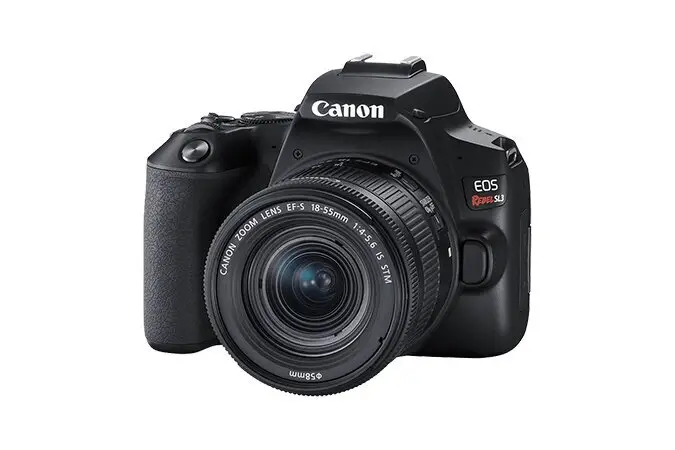
Rebel SL3 / Canon EOS 250D
Best Canon DSLR for travel
This camera is well-suited for beginner photographers with its simple guide modes that explain basic concepts. Despite its compact size, it’s powerful enough to support users as they advance to more complex techniques. Its portability makes it an excellent travel companion. The touch-sensitive vari-angle monitor, which can face forwards, caters to vlogging, selfies, and various photography styles. In the video department, it offers 4K UHD video recording for sharp and clear movies.
For stills, the 24MP sensor and Canon’s Dual Pixel autofocus deliver sharp results consistently, even in challenging lighting conditions. Additionally, it offers an impressive battery life, claiming approximately 1070 shots when using the optical viewfinder, thanks to its DSLR design.
Pros:
- Articulating monitor.
- Canon’s Dual Pixel AF.
- 4K movies.
- Impressive shot capacity with the optical finder.
Cons:
- Small viewfinder.
- 4K video comes with a 1.7x crop.
- No Dual Pixel AF in video mode.
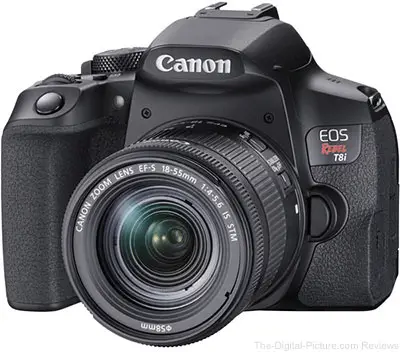
Rebel T8i / Canon EOS 850D
Best Canon DSLR for enthusiasts
The EOS 850D presents a well-rounded package and is an excellent choice for enthusiast photographers eager to explore their creative potential. With the 18-135mm USM lens, it becomes a compact and lightweight package with a versatile zoom range, suitable for various photography subjects.
The camera’s 24.1MP sensor, coupled with the Canon DIGIC 8 processor, delivers outstanding images with exceptional detail and vibrant colors. It features an ISO range from 100 to 25,600, ensuring successful shooting in low-light conditions. However, its 4K video comes with a 64% crop, limiting the field of view, and lacks Dual Pixel AF, leading to slower live view autofocus. Shooting in 1920 x 1080 full HD doesn’t impose these restrictions.
Pros:
- Excellent picture quality.
- Vari-angle touchscreen.
- 7fps shooting with AE/AF tracking.
- Offers a robust build.
Cons:
- Small optical viewfinder.
- Limited video features and performance.
- Fixed 3.2-inch monitor.
- Modest Live View shooting at 4.3fps with AF tracking.
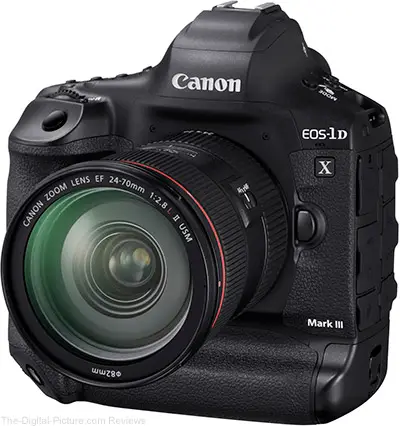
Canon EOS-1D X Mark III
Best professional Canon DSLR for sports and action
The EOS-1D X Mark III’s outstanding native ISO range ensures you can capture remarkable shots even in challenging lighting conditions. Its high-speed capabilities, both through the optical viewfinder at 16fps and Live View at 20fps, are invaluable for capturing fast-moving subjects, making it a top choice for professional sports and action photographers.
The AF system boasts 191 points, with 155 cross-type points, and features Canon’s Deep-Learning AF Algorithm, which can even recognize faces when they are upside down.
Pros:
- Professional-level build quality.
- Exceptional ISO range.
- High-speed shooting.
- Dual card slots, supporting CompactFlash and SD.
Cons:
- High initial cost.
- Large and heavy body.
- Resolution may be considered too low for scenic and studio photography.
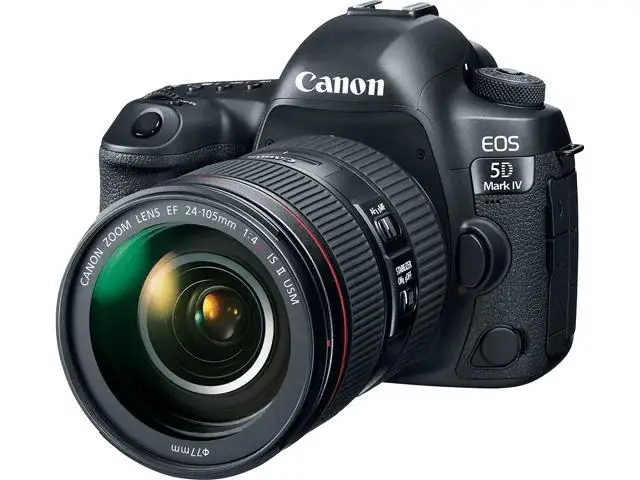
Canon EOS 5D Mark IV
Best professional Canon DSLR all-around
This rugged DSLR’s combination of advanced weather sealing and a high-resolution 30.2MP full-frame sensor delivers exceptional image quality. With low noise, excellent dynamic range, and lifelike colors, it excels in various scenarios, making it a favorite for landscape photography. It also serves as a versatile all-rounder suitable for a wide range of professional and commercial subjects.
The EOS 5D Mark IV features Dual Pixel RAW (DPRAW), allowing imaging data capture from two slightly different perspectives for post-processing adjustments using Canon’s DPP software. This can fine-tune lighting, focus points, and background bokeh, though it involves some technical expertise, and the effects may not always be immediately evident.
Pros:
- Excellent image quality.
- Robust build with outstanding handling.
- Impressive high ISO performance.
- Dual Pixel AF with face detection and tracking.
Cons:
- Non-adjustable 3.2-inch screen
- Live View shooting offers a limited 4.3fps speed with autofocus tracking.
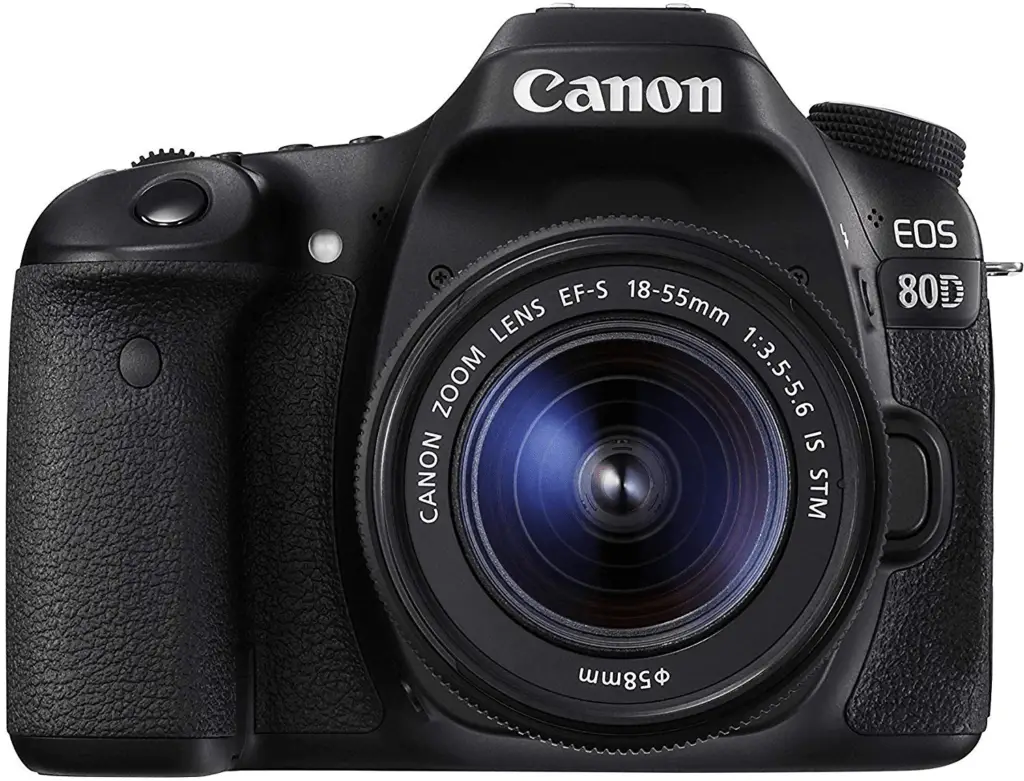
Canon EOS 80D
Best used Canon DSLR for enthusiasts
The EOS 80D is well-regarded for being an APS-C all-rounder, delivering a remarkable shooting experience with a high-quality optical viewfinder covering the entire frame. It features 45 highly accurate cross-type AF points, making it a capable DSLR in most shooting situations. Additionally, its Full HD video capabilities at 60p and vari-angle touchscreen make it a suitable choice for videography, although it doesn’t support 4K video.
Pros:
- Precise focusing in all modes.
- Excellent build quality.
- Impressive video specifications.
Cons:
- Limited to Full HD video.
- Single card slot.

Canon EOS 7D Mark II
Best used Canon DSLR for action and sports photography
Introduced in 2014, the EOS 7D Mark II incorporates advanced AF features from the EOS 5D Mark III and EOS-1D X, including Dual Pixel sensor technology, a 65 cross-type AF system, and Intelligent Tracking and Recognition (iTR).
These features make it highly suitable for fast-action and sports photography. The camera’s advanced weather sealing further enhances its durability for outdoor use. Additionally, it offers dual card slots, with support for both CompactFlash and SD cards.
Pros:
- High-speed shooting at 10fps.
- Utilizes Dual Pixel AF.
- Dual card slots for storage flexibility.
- Environmentally sealed and durable body.
Cons:
- Lacks a touchscreen.
- Features a fixed monitor.
- Inconsistent iTR performance.
- No built-in Wi-Fi.
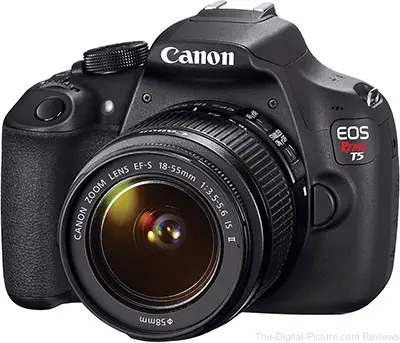
EOS Rebel T5 / Canon EOS 1200D
Best used Canon DSLR for beginners
The EOS 1200D retains its reputation as an excellent, all-around DSLR for beginners. With its 18MP sensor and fast and accurate autofocus system, it’s a reliable choice for those new to photography.
Though it features only 9 AF points and a 3fps burst rate, it can handle most basic shooting scenarios effectively. Notably, it performs well in low-light conditions and urban night shoots.
Pros:
- Excellent value on the used market.
- Reliable autofocus system.
- Good high-ISO performance.
Cons:
- Limited to 3fps.
- Features only 9 AF points.
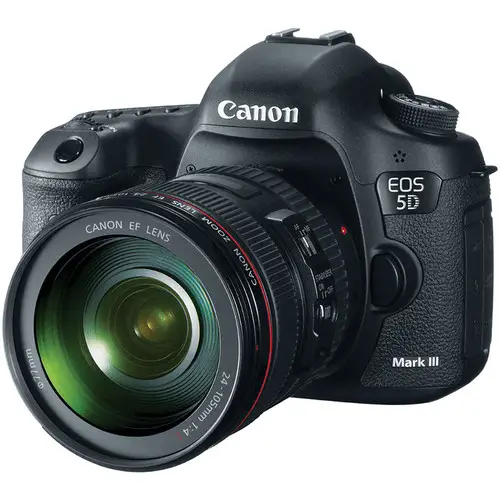
Canon EOS 5D Mark III
Best used Canon DSLR for video
The EOS 5D Mark III, initially released in 2012, offers high-quality images with its 22MP full-frame sensor, a reliable 61-point AF system, and a 63-zone metering system for accurate exposures. It has made its way to the second-hand market, providing an affordable option for photographers.
This camera was revolutionary for High Dynamic Range (HDR) shooting, as it could bracket exposures and merge them in-camera. Additionally, it supports multiple exposures for creative effects. However, potential buyers should consider the shutter actuations, as this camera’s shutter is rated at 150,000 actuations.
For videographers, the EOS 5D Mark III has played a significant role in the evolution of run-and-gun filmmaking, providing excellent Full HD video quality. It addressed some issues from its predecessor, the Mark II, including reducing rolling shutter effects. Still, it falls short in terms of 4K video support, a feature desired by many video shooters. Furthermore, it lacks some features available on newer cameras, such as a fully articulating screen.
Pros:
- Solid build quality.
- Excellent Full HD video capabilities.
- 6fps continuous shooting.
Cons:
- Slower Live View autofocus and face detection compared to newer models.
- Fixed rear screen.

Canon EOS 6D
Best used full-frame Canon DSLR
The EOS 6D, introduced in 2012 as a more affordable alternative to the EOS 5D Mark III, offers excellent value for a full-frame camera. It utilizes a 20.2MP sensor and the same DIGIC 5+ image processor as its more advanced sibling. The camera provides a native ISO range of 100-25,600, with expandable settings, catering to a wide range of lighting conditions.
With its compact and lightweight design, constructed from magnesium alloy, the EOS 6D is portable and suitable for those who prefer full-frame DSLRs without excessive bulk. It remains an excellent choice for users seeking a cost-effective path to full-frame photography.
Pros:
- Attractive price for full-frame capability.
- Lightweight and portable design.
- Excellent image quality, especially in low light.
Cons:
- Lacks a built-in flash.
- Max flash sync of 1/180sec.
- Utilizes a basic 11-point AF system.
How to Select the Best Canon DSLR Camera?
When choosing the best Canon DSLR for your needs, several key factors should be considered:
Resolution
Resolution, often measured in megapixels, determines the level of detail your camera can capture.
While higher megapixels offer more detail, even cameras with modest resolutions can produce professional-quality prints when combined with sharp lenses and proficient camera technique.
A basic model like the Canon EOS 4000D with 18MP resolution can create detailed prints, including large A2-sized ones. The choice of resolution depends on your specific requirements.
APS-C vs. Full-Frame
Canon DSLRs come in two sensor sizes: APS-C and full-frame. APS-C cameras are suitable for many users, providing excellent image quality, compact camera bodies, and more affordable lenses.
Full-frame cameras are favored by dedicated enthusiasts and professionals due to superior image quality, expanded dynamic range, and improved low-light performance. However, they tend to be larger, heavier, and pricier. Choosing between APS-C and full-frame depends on your preferences and specific photography requirements.
Autofocus
Canon DSLRs employ two autofocus systems – one for the optical viewfinder and another for live view on the LCD screen. Dual Pixel AF, introduced by Canon in 2013 and now available on most recent DSLRs like the EOS 90D, utilizes dual light-sensitive diodes for each pixel on the imaging sensor.
This technology enables rapid, reliable focusing for both stills and video. Dual Pixel CMOS AF is a standard feature in newer Canon DSLRs and is highly recommended.
Video
While Canon DSLRs once led the video revolution in the mid-2000s, contemporary videographers may find mirrorless models more suitable.
Recent Canon mirrorless cameras offer features like 4K, 4K Cine, 6K, and 8K, as well as in-body image stabilization, which is unavailable on Canon’s DSLRs. For video-centric usage, mirrorless cameras provide more advanced features and performance.
The Canon EOS 90D is a capable DSLR for video shooting, but mirrorless models excel in this regard. Keep in mind that video recording is available on many Canon DSLRs, including the models mentioned. For professional filmmaking, stable footage can be achieved with high-quality tripods.


